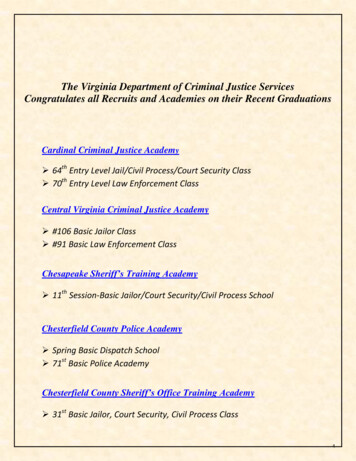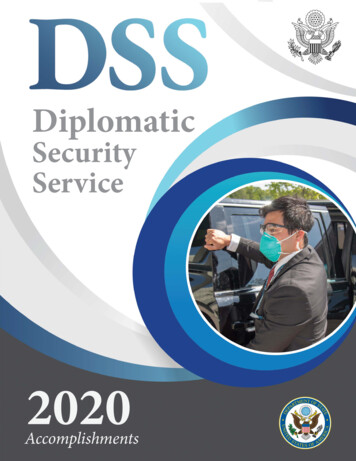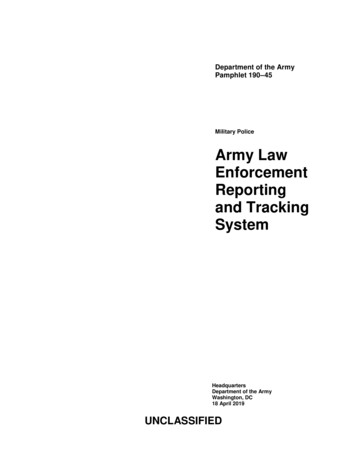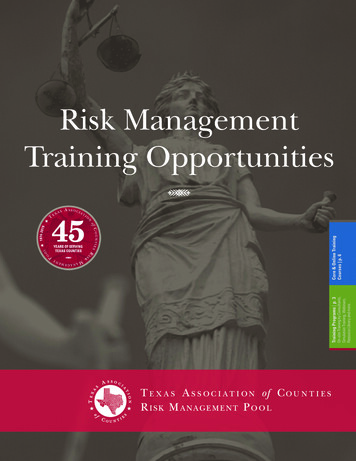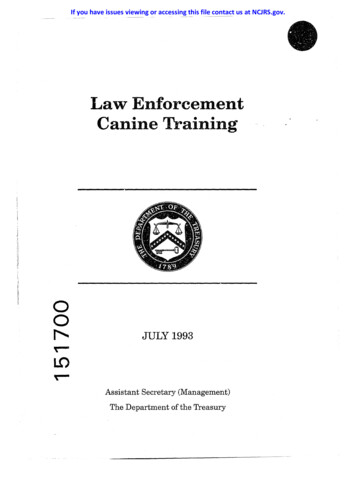
Transcription
If you have issues viewing or accessing this file contact us at NCJRS.gov.Law EnforcementCanine Trainingoof'JULY 1993Assistant Secretary (Management)The Department of the Treasury
/511f)()fDEC 12 1994Law EnforcementCanine TrainingACQU SftTRON5JULy 1993151700U.S. Department of JusticeNational Institute of JusticeThis document has been reproduced exactly as received from theperson or organization originating it. Points of view or opinions stated Inthis document are those of the authors and do not necessarily representthe official position or policies of the National Institute of Justice.Permission to reproduce thisgranted by: t ',It41 material has beenPubliG-DGmain ---------------- IT.S. Department of Treasuryto the National Criminal Justice Reference Service (NCJRS).Further reproduction outside of the NCJRS system requires permissionof the"""" owner.
LAW ENFORCEMENT CANINE TRAININGEXECUTIVE SUMMARYThis study of law enforcement canine training at theTreasury Department describes canine training programs andtraining facilities. Descriptions of a number of programs followa section providing a comparative analysis of programs andfacilities. The major findings and recommendations are:1.Finding: Very little scientific testing of lawenforcement canine performance has been conducted.Recommendation: In order to improve the data availableto Treasury bureaus on canine training programs, atraining and field performance testing protocol shouldbe established based on an objective, scientificmethodology.2.Finding: A variety of reinforcement protocols are usedfor law enforcement canine training, but no scientificresearch which evaluates and compares these protocolswas noted.Recommend ion:A research project should beundertaken to evaluate the range of caninereinforcement protocols.3.Finding: Insufficient cost data are available on themany variables involved in law enforcement caninetraining and field activities.Recommendation: Each Treasury bureau which currentlytrains canines, or which proposes to train them, shoulddevelop detailed cost and performance data to allowfuture evaluations of efficiency and costeffectiveness.4.Finding: Analysis of the advantages and disadvantagesof initiating, expanding or consolidating lawenforcement canine training programs must address notonly cost and capacity, but also the unique missionbased needs of the bureau.Recommendation: If substantial expansions of caninetraining programs are proposed, or if a bureau whichdoes not currently train canines should propose theestablishment of a training facility, then theproposing bureau should present an analysis of thecosts and quality advantages and disadvantages ofoperating a separate versus a consolidated facility.
LAW ENFORCEMENT CANINE TRAININGTABLE OF CONTENTSIIntroductionIIComparative Analysis of Canine Programs andFacilitiesIII1A.The Various Missions of Canine Programs3B.Size of Training Programs4C.Size and Scope of Training Facilities6D.Costs of Training Facilities and Programs7E.The Best Canine For The Job, andAppropriate Training Costs9F.Class Size, Class Length and Number ofInstructors Per Class11G.Training Protocols and the Reinforcement/Reward Systems15The Effectiveness and Efficiency of CanineTraining ProgramsA.The Effectiveness of Canine TrainingPrograms19B.Effectiveness of the Reinforcement Usedin operant Conditioning20C.Efficiency of Canine Training Programs20D.Size of Training Facilities21
IVU.S. Treasury Department Law EnforcementCanine Training ProgramsA.The United states customs serviceCanine Program23B.The United states Secret Servicecanine Program34Appendix 1.Federal and state Law EnforcementCanine Training ProgramsA.United states Air Force Military WorkingDog Program39B.Connecticut state Police canine Program50C.United states Capitol Police canine Unit57D.united states Department of AgricultureBeagle Brigade60Appendix 2.Bibliography65Appendix 3.Canine Training Program Addressesand Contacts70Appendix 4.Cost of Procuring and Training A LawEnforcement CanineAppendix 5.Old Treasury Seal with Canine72Appendix 6.Acknowledgements73FiguresFigure1.Map of the customs Training Center at Front Royal252.Map of Site A, Customs Training Center at Front Royal263.Map of site B, customs Training Center at Front Royal294.The Use of Cans on a Daisy Wheel to TeachOlfactory Selection55ii
Tab esTable1.2.3.Number of Canine Teams on Active Duty and NumberNeeded to Maintain Current Service Levels forSelected Law Enforcement Agencies: Close ofFiscal Year 19925Physical Facilities of Canine Training Centersfor Selected Law Enforcement Agencies8Canine Breeds Used and Costs for Selected CanineTraining Programs124.Trainees (Canine Teams) to Instructor Ratio135.Class Size and Length of Canine Training Programs,For Selected Agencies146.Reinforcement/Reward Systems187.Criteria Used by the U.S. Secret Service forSelection of a Belgian Malinois Canine358.Scent Box Use469.Training Time Required for Each Kind of Activity52Reward Used for Positive Reinforcement for EachActivity5210.iii
IeINTRODUCTIO!fThis study of law enforcement canine team training at theUnited states Treasury Department is meant to serve as aninformation resource on canine training programs, andparticularly on canine training facilities, so that futuredecisions regarding such programs and facilities can be made withthe full benefit of baseline and comparative information.The study begins with an overview of canine training and acomparison of programs. Unless stated otherwise, the expression"canine training" should be understood to mean training a lawenforcement officer and a dog to function as a team in order toperform law enforcement functions. Discussions of the Treasurycanine training programs follow, and Appendix 1 describes otherF'ederal and state canine training programs.Two Treasury Department bureaus, the U.s. customs Serviceand the U.s. Secret Service, have active canine training programsto support their law enforcement missions. Several otherTreasury organizations have law enforcement missions, but do nottrain or maintain their own canines. These are the Bureau ofAlcohol, Tobacco and Firearms (BATF), the Criminal Investigation(eI) function of the Internal Revenue Service (IRS) and theFederal Law Enforcement Training Center (FLETC). All of theseagencies use canines from local law enforcement agencies whensuch use is necessary.The Bureau of Alcohol, Tobacco and Firearms, for example,has a National Emergency Response Team program which has beenvery effective in responding to a variety of law enforcementemergencies nationwide. As part of the work done by these teams,canines are used to detect explosives or arson accelerants.Trained canine teams are borrowed from local law enforcementagencies (state and/or local) through an established nationalnetwork. BATF maintains a close relationship with theconnecticut state Police Canine Program and frequently makes useof canines trained by that organization.Neither the U.S. Mint nor the Bureau of Engraving andPrinting, which maintain very strict security standards at theirproduction and storage facilities, utilize canines on a regularbasis to support their security programs. These Bureaus indicatedthat if a particular security situation warranted the use ofcanines, they would seek the assistance of other law enforcementagencies. The Mint, however, apparently used canines in the late18th century (see Appendix 5).1
In order to better understand Treasury canine trainingprograms, and to put them in a broader context, comparisons aremade to four other canine training programs, namely, the unitedstates Air Force Military Working Dog program, the Connecticutstate Police Canine Program, the united states Capitol PoliceCanine Unit, and the united states Department of AgricultureBeagle Brigade. Separate chapters on each of these programs areincluded in Appendix 1.2
IIoA.COMPARATIVE ANALYSIS OF CANINE PROGRAMS AND FACILITIESTHE VARIOUS MISSIONS OF CANINE PROGRAMSFor the purposes of this study, we will classify themissions of the various canine programs as being either lawenforcement or non-law enforcement. Under the classification ofnon-law enforcement programs we find missions which are both wellknown and popular.Perhaps the most widely known non-law enforcement mission isthat of the seeing-eye dog: the trained canine becomes the eyesfor one whose sight is impaired. In addition, canines aretrained for hunting, search and rescue operations (iIi snow aswell as in other conditions such as dense woods or demolishedbuildings), livestock guarding and herding, and, simply, to beobedient.This variety of non-law enforcement missions illustrates twobasic characteristics of the relationship between Homo sapiensand canines. First, the domesticated canine displays a genuinedesire to please its owner and to do 1 those things which willevoke a pleased, rewarding response.Second, the domesticatedcanine has demonstrated a remarkable ability to apply itsextraordinary scenting capability in a variety of situations, andit has clearly shown that it can learn to execute a large numberof tasks upon command. The repertoire of tasks ranges 2 fromsimply "sitting" to turning light switches on and off.'According to one author:"Indeed, one of the dog's mostdistinct characteristics is his affinity for man. Rarely is thedog thought of as an animal unto itself. Instead, stories of hiscompanionship, loyalty, and service to man abound and are wovenlike a thread through all of literature."Samuel G. Chapman.Police Dogs in North America (Charles C. Thomas, Springfield,Illinois: 1990), Chapter 1.2Jack Fincher,"All you have to do is tell them what youwant," Smithsonian (January 1992), pp 80-87. Mr. Fincher describesthe accomplishments of the Canine Companions for tndependence, anorganization that trains dogs to assist people with disabilities.Mr. Fincher writes, "It's amaz ing how many things dogs . . can dofor people who could not manage without their help. 'Service' dogscan turn light switches on and off, raise and lower window shades,lock and unlock wheelchairs, select books from shelves, open andshut doors and drawers, and carry a bedpan. . . . Another picks upits owner's immobile legs, using the tongues of her shoes, andperiodically crosses and uncrosses them to stimulate circulation."3
The law enforcement missions of the canine encompass atleast six distinct tasks: patrol duty, cadaver search, trackingfor fugitives or lost persons, and the detection of illegaldrugs, arson accelerants, and explosives. canines are seldomcross-trained to undertake more than two of these tasks; e.g.,patrol duty and detection of accelerants, or patrol duty andexplosives detection.B.SIZE OF TRAINING PROGRAMSThe determining factor for the size of canine trainingprograms is the annual demand for canines and handlers. Thisvaries by law enforcement agency, and Table 1 shows the estimatedannual demand for canines in order to maintain authorized levelof canine teams, by selected law enforcement agencies.It is immediately apparent that the size of trainingprograms is primarily a function of the rate at which canines areno longer able to perform the tasks assigned to them, due tophysical problems caused by age and length of service (much li.ketheir handler counterparts). Once a canine program has reachedwhat could be considered a current services level the number ofcanines required annually to maintain that field presence isdeterminable. Two other factors also influence the size oftraining programs: program growth and service to other agencies.An example of program growth is demonstrated by the canineenforcement officer program of the U.S. customs Service over thepast three years. The success of the program, in terms of costeffectiveness and interdiction of shipments of illegal drugs, hassupported an expansion in the number of canine enforcement teams.At the close of Fiscal Year 1989 Customs had 194 canineenforcement teams in the field. At the close of Fiscal Year 1992there were 364 canine enforcement teams at work.The combination of physical and human resources required tooperate an effective training program is flexible in that thecomFonents can be varied (once a base program is established) tohandle moderate changes in demand. But the training process isproperly characterized as being labor intensive. with a facilityof a given size, the output of a program can be varied byincreasing class size, or increasing the number of classes3Although theaccomplishmentsof caninesin non-lawenforcement programs are fascinating as well as legion, the balanceof this discussion will focus on law enforcement programs.4
conducted annually.4 As shown in the Table 1, a program can beput together which can train as few as 8 or 10 canine teams ayear. The Connecticut state Police program, for example, has thecapacity and capability of training an additional 10 canine teamsby changing class size. Unless a training program's capacity isexactly matched to the annual demandS facing it, additionalcapacity is almost always available.Table 1Number of canine Teams on Active Duty and NumberNeeded to Maintain Current service Levels for Selected LawEnforcement. Agencies: Close of Fiscal Year 1992Number ofCaninesTeams onActive DutyAgencyU. S. Customs ServiceNumberTrained EachYear toMaintain aCurrentServices Level364353852J 075300Connecticut state Police5312U.S. Capitol Police308U.S. Department clfA.griculture334U.S. Secret ServiceMilitary Working Dog ency4A program does not have to train a large number of canineteams each year to be effective and successful. In Maryland, forexample, there are at least four separate canine training programs:the Maryland State Police, Baltimore City Police, Montgomery countyPolice, and the Prince Georges County Police. The annual averagenumber of canines trained is under 10 for each program. Samuel G.Chapman.Police Dogs in North America.(Charles C. Thomas,Springfield, Illinois: 1990) p. 41, ff.Scompetent trainers and instructors are the key ingredient forsuccess in canine training programs, and there is an ample supplythanks to large programs such as that of the Military Working DogAgency.5
This brings us to the last factor affecting the size of thetraining program: service to other law enforcement agencies.Because excess capacity exists, many established programs haveresponded to the interest and needs of other law enforcementagencies by training canine teams for them. The Military workingDog Agency at Lackland Air Force Base, for example, trainsexplosives detection canines for the Federal AviationAdministration. The customs Service trains drug detection canineteams for the customs bureaus of other countries. Theconnecticut state Police trains arson accelerant and explosivesdetection canine teams for other local and state law enforcementagencies, as well as for the U.S. state Department. When serviceto other agencies becomes an established part of a program, ofcourse, its output capacity will be adjusted to reflect theconsistent demand.C.SIZE AND SCOPE OF TR1iINING FACILITIESGiven the level of annual demand for canines, the facilitiesrequired will be tailored to that program. certain basicrequirements will normally be present: large fields forobedience training and obstacle courses, classroom space,administrative offices, veterinary clinic, supply rooms, kennels,and parking lots and rooms or buildings which can be used tosimulate actual working environments. Whether all of these willbe present will depend on the scope and size of the trainingprogram. The facilities at Lackland Air Force Base (LAFB), wherethe Military Working Dog Agency (MWDA) is located, includes allof these elements; and there are special features of the MWDAprogram which set it apart from smaller, more typical programs.Lackland Air Force Base is a major basic training facility,and it is in a state of transition; quarters for trainees arebeing gradually upgraded, and older World War II buildings arebeing replaced or made available for the use of the MWDA.consequently, many buildings are available; one building has beenconfigured as a warehouse in order to simulate an environmentwhere drug or explosives detection canines might be working.Another is set up as a military barracks so that the canineswould be accustcmed to working in living quarters of militarypersonnel.In other programs we observed, these working environmentswere supplied by local, private sources. Both the Connecticutstate Police and the U.s. Customs enjoyed good workingrelationships with warehousing operations, and their canines werewelcome for training exercises during business hours. TheConnecticut state Police have an arrangement with aninternational airport, and the airlines using it, to traincanines in luggage areas and in aircraft.6
An important facility in two of the programs we observed wasthe parking lot with a variety of vehicles used in trainingexercises: searches, drug detection and explosives detection.The vehicles are maintained in good physical (but not running)condition, and are usually obtained through forfeiture orconfiscation operations. Included are vans, pickup trucks,buses, sedans, etc., which have been modified by installing extracompartments where contraband materials may be hidden. Again,the objective is to mimic the real world.The inclusion of veterinary services is another example ofthe difference program size makes. Moderate or modest sizeprograms have found that it is practical and satisfactory tocontract for veterinary services from local veterinarians. Theonly program whose scale made it economically viable to include acomplete veterinary clinic was that at Lackland Air Force Base.Table 2 presents a summary of the scope of the facilitiesfor selected programs. To summarize this discussion on size andscope of facilities, it is worth repeating that the annual demandfor canine enforcement teams will, in most instances, be thedetermining factor for the size of the training facility.D.COSTS OF TRAINING FAC!LITIES AND PROGRAMSData on the acquisition costs of most of the facilitiesvisited were no·t readily available, so a full-scale comparativeanalysis of the capital costs of facilities would be difficult toundertake. However, data were available for the U.S. SecretService (USSS). In Fiscal Year 1983, a small building and sevenkennel runs were built for the USSS at a cost of 500,000. It isestimated that the kennel runs cost approximately 17,000 each.It is not possible, however, to estimate the average annualcapital cost per canine trained because of an extensivereinforcement training program. This program operates on a dailybasis since all canine enforcement teams in the Washington areaundergo weekly reinforcement training. In Fiscal Year 1991, theUSSS added another eight and a half kennel runs at a total costof 152,000. The average cost of each run, therefore, was justunder 18,000.Although highly detailed data on the costs associated withthe training programs of the selected agencies we visited werenot readily available, the data we did obtain made it possible toconstruct an estimate of the per-canine cost for each program.These data are presented in Appendix 4 for selected agencies.7
------ .---------------------------------Table 2Physical Facilities of canine Training centersFor Selected Law Enforcement iceMilitaryWorkingDog AgencyConnecticut statePoliceu.s.DepartmentofAgricultureu. ation Buildings41*61*2*1*Total7115131Parking Lots112000KennelBuildings314120131614Kennel Runs* 15116690dual use buildings.
The per-canine data presented are not strictly comparablebecause of a number of variables which change from agency toagency. For example, only the u.s. Secret Service and the6Military Working Dog Agency purchase their canines in Europe.Other variables which are not consistent between agencies are theclass sizes and th"e number of weeks per class. Finally, thequality of the canine produced varies from 91 percent to 95percent proficiency. All these variables have a direct,important impact on the per-canine cost of training.Intuitively, economies of scale should be enjoyed astraining programs increase in size. The Military working DogAgency (MWDA) , for example, appears to enjoy a lower per-caninetraining cost than that of the other three agencies (rememberingthat the Connecticut state Police do not pay for their dogs.)This may be the case, but since there are so many importantvariables whose values differ, a detailed cost analysis wouldneed to be rffected in order to make any definitive findings onthis issue.Finally, it is worth noting again that canine training is alabor intensive process. Economies of scale are certainlyavailable in terms of organization and management as programsexpand. These are not, however, as dramatic as those economiesassociated with spreading capital costs over larger and largeroutputs.E.THE BEST CANINE FOR THE JOB, AND APPROPRIATE TRAINING COSTSPatrol DogsTo be effective, patrol dogs must be strong and large. Thecanine must be able to physically stop, or at least intimidate, asuspected perpetrator. The German Shepherd and Belgian Malinoisseem to fill this role especially well. In addition to theirstrength and mobility, these two breeds are highly intelligent,very social and they have exceptional olfactory capabilities.6The preferred breeds are the Belgian Malinois or the GermanShepherd, and these are purchased in the Netherlands or in Germany.7Forexample, the MWDA is located in San Antonio, Texas, wherethe year-round, very mild climate eliminates the need for extensiveheating facilities.9I
Finally, they have been bred so that their aggressivecharacteristic is very strong. The MWDA at Lackland Air ForceBase will purchase either breed, although they have begun to leantoward the Malinois as the preferred breed. The u.s. SecretService prefers the Malinois, and restricts current acquisitionsto that breed. Both organizations purchase the canines inEurope.Detector DogsA detector canine must display two basic characteristics,and almost any breed displaying such characteristics can be usedas a detector. The canine's temperament must be sound and itmust demonstrate a very bold attitude. This latter trait is oneof independence and is reflected by the canine being hyperactive,very alert and inquisitive to all activity in its surroundings.The canine should not be aggressive toward people, but it shouldhave an outgoing attitude, indicating the canine is convincedthat the space it occupies belongs to it and that it willchallenge anyone who attempts to drive it from that space.The canine must also demonstrate a very strong, almostfrantic, desire to retrieve a thrown object (sometimes referredto as a dummy). The animal must alsr display a very possessiveattitude toward the retrieved dummy.The U.S. customs Service subscribes to this view, and theyrecruit their canines largely from animal shelters in locationsalong the Eastern Seaboard and the Midwest. Selection of caninesis focused toward the larger breeds of working and sporting dogssuch as German Shepherds, Golden Retrievers and LabradorRetrievers. It is not required that the canine be pedigreed.The selection criteria motivating canine acquisition at thecustoms Service are accepted in varying degrees by otheragencies, occasionally with modest modification. The Connecticut8Department of the Treasury, U. S . Customs Service.U. S.customs Detector Dog Program (Washington, D.C.:1978).Thebehavior described is very important since subsequent training isdesigned to develop and sustain a strong motivation to recover thedummy.During training the dummy becomes associated with thetarget substance, and the canine's aggressive response is actuallymotivated by a desire to retrieve the dummy and to play with it andthe handler.10
state Police, for example, will accept the large, sportingbreeds, wi h a marked preference for the Labrador and the GoldenRetriever.Table 3 presents a summary of the breed and cost of caninesused by selected canine programs. A canine with acceptablecharacteristics, meeting the selection criteria of a particulartraining program, can be acquired for a cost ranging from zerodollars to approximately 2,500. Each program we observed hasexpressed satisfaction with its selection process and with theoutcome: a canine trained for patrol duties or detection ofdrugs, explosives or accelerants.F.CLASS SIZE, CLASS LENGTH AND NUMBER OF INSTRUCTORS PER CLASSWe noted previously that the variables of class size andduration of the training class were important factors indetermining the per-canine costs of any training program.Another variable affecting per-canine costs is the number ofstudents (i.e., canine teams) per instructor. The student toinstructor ratio for selected training programs is presented inTable 4. In Table 5 we present a summary of the two variablesclass size and length of training for selected training programs.It is apparent that there i.s significant variability in thestudent to instructor ratio among the programs we observed.This is an important factor explaining the differences in percanine training costs.9These dogs are obtained from Guide Dogs for the Blind insmithtown, Long Island, and Guiding Eyes for the Blind inPatterson, New York. These organizations place pups in the homesof volunteers who raise the animals in a family atmosphere for 10to 14 months. The objective is to enable the canines to developsocial characteristics and to experience a home environment as aprelude to training and placement. Canines which are not deemedsuitable to be seeing-eye dogs are given to the Connecticut statePolice without charge.11
Table 3CANINE BREEDS USED AND COSTS FORSELECTED C INE TRAINING PROGRAMSAgencyU.s. Customs ServiceBreed ofcanine UsedApproximate Costof Acquisition(includingtravel)Various,sporting &Retriever(canines aredonated)U.s. Secret ServiceMalinois 2,500Military Working DogAgency (USAFl 1}German Shepherdand Malinois 2,000Connecticut state PoliceGerman Shepherd,Bloodhound,Labrador andGolden RetrieverNone(canines aredonated)U.S. Capitol PoliceGerman Shepherd 2,000 6001/ Sporting breeds such as Labradors and Golden Retrievers aretrained for explosives detection at the Federal Aviation Administration, andother small breeds (i.e., Beagles and Terriers) are trained for other specialprojects.12
Table 4TRAINEES (CANINE TEAMS) TO INSTRUCTOR RATIOAgencyCanine trained for:PatrolU. S. Customs ServiceDrugExplosivesAccelerantsn/a6n/an/aU.S. Secret Service6nja6n/aMilitary Working DogAgency JUSAF)3333Connecticut state Police3.7331.7U.S. Capitol Police666n/a Not applicableNote: A canine team includes a handler and a canine.13n/a
- -------------.---- --Table 5CLASS SIZE AND LENGTH OF CANINE TRAININGPROGRAMS, FOR SELECTED AGENCIESClass Size:AgencyI-'01::: PatrolDrugAverage Number ofTrainees(a)ExplosivesAccelerantsClass Length:PatrolDrugNumber of WeeksExplosivesU.S. customs Servicen/a6n/an/an/a10U.S. Secret Service(b)n/a6n/a(b)n/aMilitary Working DogAgency (USAF)(c)161212n/a538.5Connecticut statePolice116651466666n/a141012U.S. Capitol PoliceAccelerantsn/an/a20n/an/a7n/an/a not applicableNOTES:(a) All classes are for teams, which include a handler and a canine.(b) All canines are cross-trained for patrol duty and detection of explosives.(c) Canines are cross-trained for patrol and one of the two target scents: drugs or explosives.
G.TRAINING PROTOCOLS AND THE REINFORCEMENT/REWARD SYSTEMScanine training pro rams are premised on operantconditioning principles.The behavior modification sought incanine training programs is achieved through a paradigm withthese three basic components: the cue, the response, and thereinforcer.Such a model, with respect to canines, would be thissequence: the "Sit" command is given; the dog sits; and the doggets a reward. In more formal terminology:In the presence of an environmental cue (suchas the command 'Sit') a particular operantresponse (the dog sits down) will produce anevent called a reinforcer. If this is apositive reinforcer, such as food or praise,it will increase the probability that the dogwill sit when the command "sit" is given.A positive reinforcer is a stimulus or eventthat follows an animal's response andincreases the probability of the recurrenceof that response. . . Posit ve reinforcementis a reward for a behavior.10Behavior and learning theory has identified two kinds ofbehavior: respondent and operant. The former refers to reflexiveresponses that are elicited by changes in the environmentidentified as stimuli. The salivating dog of Pavlovian renown isan example of respondent behavior,a result of classicalconditioning. Operant behavior refers to voluntary responses whichhave an effect on the environment.One psychologist developedobjective methods of studying the learning process empirically, andsummarized the findings of his research in the Law of Effect. Thisstated that behavior is primarily influenced by its effects, andthat an act that is followed by a satisfying effect is likely to berf. peated.Scott Spreat and Susan Rogers Spreat, "LearningF'rinciples", Veterinary Clinics of North America:Small AnimalPractice. Vol. 12, No.4 (November 1982).11 LL.,b' dpg. 597.15
All the training programs we obser ed followed a trainingprotocol based on operant conditioning. 1 As previously noted,however, the programs differed on such matters as student-toinstructor ratio, class size and class length. Two additionaldifferences are the record keeping regimen and thereinforcement/reward system used in operant conditioning.One program maintains detailed statistics on the canine'sperformance during each training exercise and for the duration ofthe training program. Other programs recorded performance onlyat the conclusion of training.As to the reinforcement/reward system used, t
"canine training" should be understood to mean training a law enforcement officer and a dog to function as a team in order to perform law enforcement functions. Discussions of the Treasury canine training programs follow, and Appendix 1 describes other F'ed
